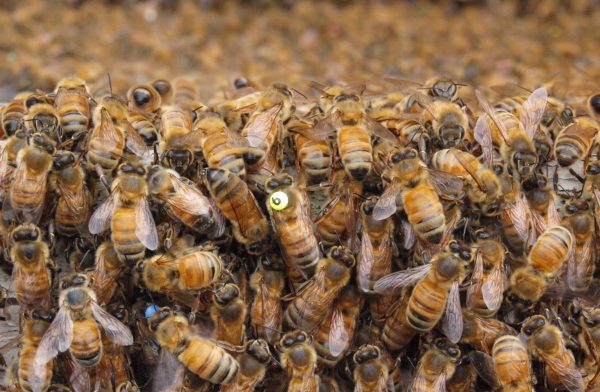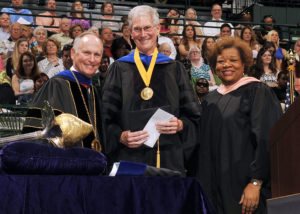Schneider’s Work Holds Potential for Honeybee Health

Honeybee colonies continue to disappear because of a mysterious condition called Colony Collapse Disorder, which threatens pollination and influences the world’s food supply.
The decline has stimulated an enormous body of research to understand the reasons behind the decline of bee populations. UNC Charlotte’s Stan Schneider and colleagues are exploring how honeybees communicate, with potential implications for honeybee health.
“I’ve always been interested in the evolution of social behavior and how solitary animals have evolved to live in social groups and especially the very complex societies like honeybees and human societies,” said Schneider, a professor in the Department of Biological Sciences.
“Initially I was more focused on individual communication signals that were used to coordinate specific activities, and now I’m more interested in the global process of decision making in insect colonies and how hundreds or thousands of individuals interact to generate a group level response that’s adaptive,” he said.
“In other words, I am looking at how a group makes a decision and how interactions among individuals generate this group level decision in an adaptive manner. Of course, what natural selection will act upon is the consequence of those decisions. And so, selection is acting at the level of the colony, not just the level of the individual.”
His lab researches the communication signals that regulate and adjust colony activities in response to changing conditions. He explores something called the waggle dance to determine how it is used to regulate colony-level foraging activity and movement.
The lab also studies the role of the vibration signal in regulating cooperative activities within colonies. The research has determined that the signal functions as a type of modulatory communication signal that causes a non-specific increase in activity. It enhances many different behaviors, including foraging, brood care, food processing, nest maintenance, swarming and house hunting.
“It’s a way of fine-tuning responses,” Schneider said. “It helps to coordinate what many individuals are doing by up-regulating or down-regulating the likelihood that they’ll pay attention to other things in a similar manner. It’s like music. Music has a modulating influence on our behavior. We use music to set moods to change motivational state and also to coordinate activities.”

Schneider and colleagues have published numerous papers and articles on their work. He most published an article in Laboratory Animal Science Professional.
In one publication, Schneider and colleagues published some of their latest findings in the journal Animal Behavior, in an article titled “The possible role of ritualized aggression in the vibration signal of the honeybee, Apis mellifera.” Other authors are R. Skaggs, J.C. Jackson and A.L. Toth.
“The complex social networks from which these group decisions emerge are based on communication,” Schneider said. “Something I’m very interested in is how did these communication signals evolve? It’s logical to assume communication signals in social species evolved from interactions in solitary ancestors;, that those interactions laid the groundwork for the evolution of these complex communication signals we see today in highly social species.”
The research team looked at gene expression patterns associated with the performance of the communication signal called the vibration signal. “Honeybees use this signal to help coordinate many of the collective activities they engage in, including the raising of new queens and interacting with new queens,” Schneider said.
“We compared gene expression patterns from workers that are performing that vibration signal, for genes that are known to be associated with aggression in primitively social species,” he said. “The data suggest the vibration signal is a form of ritualized aggression and that this signal, which is now used in the context of cooperation evolved from interactions that in the ancestors were aggressive.”
This suggests that these genes associated with aggression in ancestors in primitive species were co-opted in more advanced cooperative societies. The process set in place the genetic underpinning for communication signals that now are associated with cooperation in the complex societies.
Schneider’s research holds significance in the quest to understand honeybee health.
“Central to honeybee health is the behavior and reproduction of the queen,” he said. “One thing I’ve become interested in in the last decade or so are worker-queen interactions and how these contribute to colony health by contributing to a healthy successful queen and thus a healthy, successful colony.”
One aspect of the research looks at how workers interact with virgin queens when colonies are raising replacement queens to see how workers influence the outcome of the queen replacement process and how they contribute to higher quality queens becoming the new queens of the colony.
“The more we understand about colony reproduction and the collective decision making that governs reproductive output, the more we may be able to maintain colony health,” he said. “Related to that, we’ve also started looking at how workers interact with drones – the males – which has been largely ignored. Of course, the health and mating status of males is the flip side of colony reproductive success and colony health.”
Through the decades of research in his lab, Schneider has engaged numerous undergraduate and graduate students in the work. He has seen many of them go on to become doctors, researchers, veterinarians and published authors.

Schneider with Chancellor Philip Dubois and BOG Member Pearl Burris-Floyd
At the May 14, 2016 College of Liberal Arts & Sciences’ commencement ceremony, Schneider received a 2016 UNC Board of Governors Award for Excellence in Teaching.
This annual honor recognizes one professor at each of North Carolina’s public institutions. The 17 recipients are nominated by individual campus committees and selected by the Board of Governors’ Committee on Personnel and Tenure. Each award winner receives a $12,500 cash prize and a commemorative bronze medallion. Pearl Burris-Floyd, a member of the UNC Board of Governors, presented the award.
In fall 2015, Schneider was named the recipient of UNC Charlotte’s top teaching award, the Bank of America Award for Teaching Excellence.
In 2014, he received the College of Liberal Arts & Sciences’ Award for the Integration of Undergraduate Teaching and Research. He has served as principal investigator or co-principal investigator on grants totaling over $1 million, including funding to support undergraduate research.
“I think it’s very important to take students through the entire process to completion, and completion is having the results published in a peer-reviewed journal,” he said. “They understand the importance of communicating your findings with the larger audience. That benefits them, and it benefits us and the university.”
Close to 60 percent of the Biological Sciences Honors students working with Schneider have published with him, some with multiple publications. Because of the finite time period during which undergraduates work with him, obtaining enough data to publish can at times prove difficult. This remains a goal for him, however.
“In a university, teaching and research are inextricably interlinked,” he said. “Lectures give people the background information necessary to train them to start applying it. Research training trains them to generate that knowledge themselves. So, you can’t separate the two. The interaction of those two is what moves education forward and what moves human understanding forward.”
Schneider also takes time to present on the topic to community groups, such as a talk to the Cabarrus County Beekeepers in 2019.